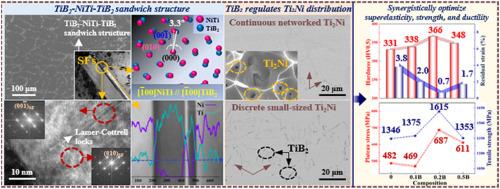In situ synthesis of TiB2-NiTi-TiB2 sandwich structure for tailoring Ti2Ni to synergistically optimize strength, ductility, and superelasticity of NiTi wires
IF 7
2区 材料科学
Q1 MATERIALS SCIENCE, MULTIDISCIPLINARY
引用次数: 0
Abstract
The brittle Ti2Ni phase induces crack initiation and causes premature failure in NiTi alloys. This study demonstrates that introducing 0.2 wt% B element into NiTi alloy promotes in-situ formation of layered TiB2, forming a semi-coherent TiB2-NiTi-TiB2 "sandwich" structure, which effectively suppresses the generation and growth of Ti2Ni particles at subsequent grain boundaries. The semi-coherent interface between TiB2 and the matrix, bonded through stacking faults, significantly strengthens the NiTi alloy, allowing it to withstand greater stresses during the elastic deformation stage. Furthermore, this interface structure enhances the continuity of reverse martensitic transformation in alloy wires, mitigating local stress concentration and optimizing superelasticity while maintaining excellent ductility. However, excessive B (0.5 wt%) triggers detrimental blocky TiB2 formation, exacerbating stress concentrations. These findings indicate that precise control of B addition can achieve ideal TiB2-Ti2Ni coupling, providing a novel strategy for synergistically enhancing strength, ductility, and superelasticity in NiTi wires.

原位合成TiB2-NiTi-TiB2夹层结构,用于剪裁Ti2Ni,以协同优化NiTi丝的强度,延展性和超弹性
脆性Ti2Ni相在NiTi合金中诱发裂纹萌生,导致其过早失效。本研究表明,在NiTi合金中引入0.2 wt%的B元素可促进层状TiB2的原位形成,形成半共格TiB2-NiTi-TiB2“三明治”结构,有效抑制后续晶界处Ti2Ni颗粒的生成和长大。TiB2与基体之间的半相干界面通过层错结合,显著增强了NiTi合金,使其在弹性变形阶段能够承受更大的应力。此外,这种界面结构增强了合金丝中反向马氏体相变的连续性,减轻了局部应力集中,优化了超弹性,同时保持了优异的延展性。然而,过量的B (0.5 wt%)会引发有害的块状TiB2形成,加剧应激浓度。这些发现表明,精确控制B的添加量可以实现理想的TiB2-Ti2Ni耦合,为协同提高NiTi丝的强度、延展性和超弹性提供了一种新的策略。
本文章由计算机程序翻译,如有差异,请以英文原文为准。
求助全文
约1分钟内获得全文
求助全文
来源期刊

Materials Science and Engineering: A
工程技术-材料科学:综合
CiteScore
11.50
自引率
15.60%
发文量
1811
审稿时长
31 days
期刊介绍:
Materials Science and Engineering A provides an international medium for the publication of theoretical and experimental studies related to the load-bearing capacity of materials as influenced by their basic properties, processing history, microstructure and operating environment. Appropriate submissions to Materials Science and Engineering A should include scientific and/or engineering factors which affect the microstructure - strength relationships of materials and report the changes to mechanical behavior.
 求助内容:
求助内容: 应助结果提醒方式:
应助结果提醒方式:


